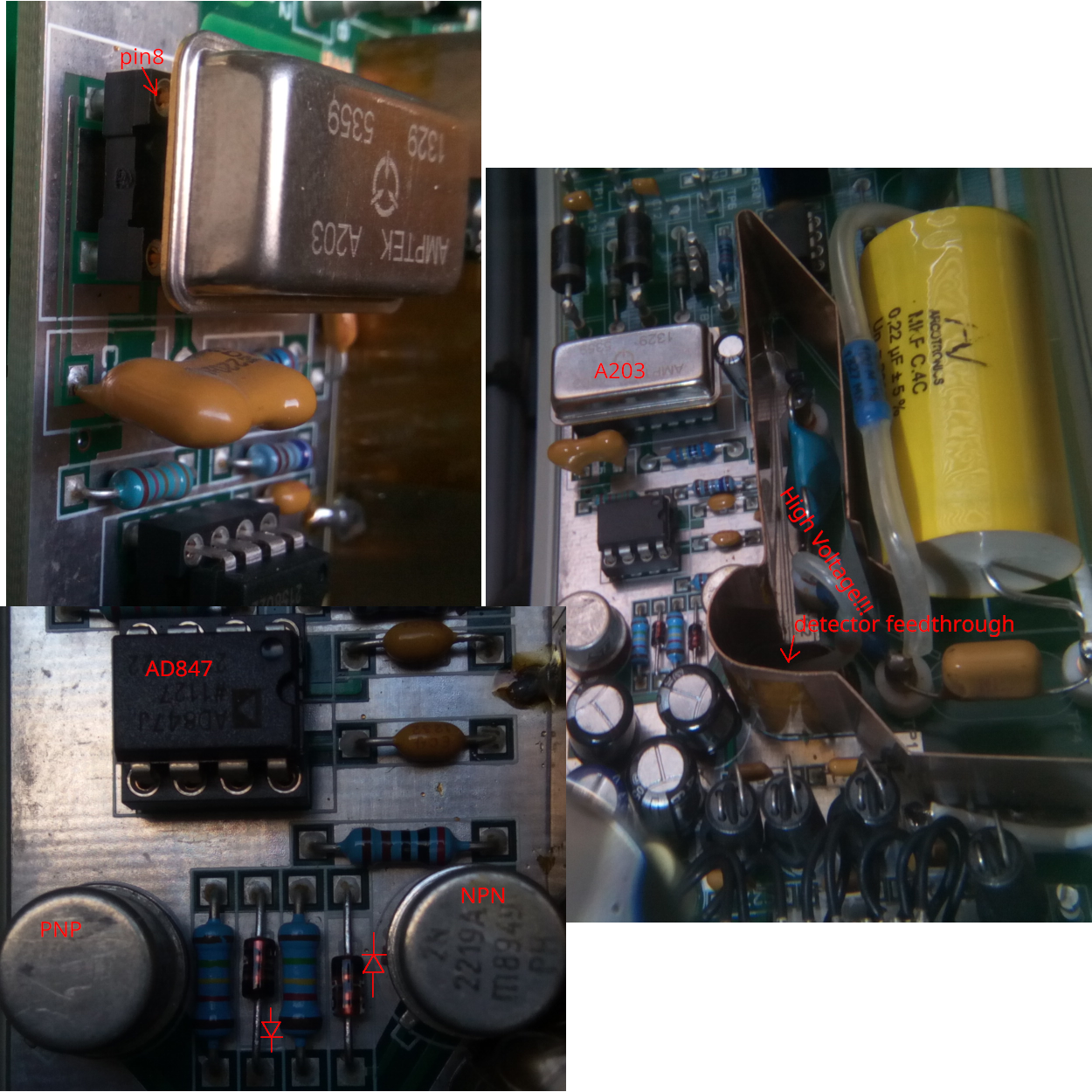OK, then are you saying that the Cameca instrument performs an extra step of converting from mono-polar to bipolar pulses, that the JEOL electronics does not? And that is the reason for the thinner PHA peaks on the Cameca pulse processing electronics?
Sorry if I ask dumb questions, I am not familiar at all with these electronic details.
Those are not dumb questions, those are actually very valid questions, just a bit in this context inpatient like "a-cart-attached-before-the-horse". The answer is, unless someone would invite me to peek into Jeol Probe electronics (at least to detector electronics), it is hard to tell.
So if we open the case where the Shapping of pulse takes place we see this (My kind reminder: DEADLY high voltage is present on part of such board):

The Charge-Sensitive Preamplifier (CSP) and the Shapping Amplifier (SA) are packed inside single a single chip produced by Amptek - A203. The SA on that chip offers both: bipolar (pin9) and unipolar (pin8) outputs, however from visual inspection it is clear that Cameca uses unipolar (pin8, a clear trace from it, then around A203 to the capacitor for decoupling, which is required by documentation of A203) output from that chip and by components placed on the shielded ground plane (which points to very careful design for sensitive signal handling) it is clear that it does the 2nd differentiation on its own implementation (with OPAMP AD847). But why? I believe it is as A203 is not able to drive terminated (75ohm) coaxial cable on its own as A203 bipolar output is rated for 2kohm impedance - connecting such signal directly to terminated coaxial (75ohm) would lower down the amplitude a lot (x30 times), thus I think Cameca uses its own implementation with 2nd differentiation of monopolar pulses and (what I suspect from clearly visible two diodes and connection with NPN and PNP transistor pair) signal after that differentiation goes through class AB power amplifier (the short explanation what it is:
https://www.elprocus.com/class-ab-amplifier/) as signal needs to be driven through few meter terminated coaxial cable to the gain and counting electronics. Just a side note: there are hardly any high speed OPAMPS which could directly drive such loads at these voltages (+/-15V), and thus the engineering of Cameca in this regard is a top notch.
So to answer the question if Jeol "shortcuts" on signal handling and thus PHA distribution suffers because of that - that would need similar inspection on Jeol hardware side: We need to know, what CPS and SA it uses (i.e. A203 is unique in its integration of both CSP and SA into single package - but it is possible to use separate CSP and SA chips (i.e. produced by Cremat inc.) to get the similar functionality), what kind of coaxial cable is used to send the signal from detector to counting board. Design for a few hundred of thousands of pulses a second is not complicated. However with Million pulses in second a single weak point in design can cause the amplitude drop.
This 75 ohm terminated coaxial cable is making me a headache for my planned experiment with external pulse generator. This means I will need to implement some fast class AB power amplifier if I want to simulate the pulses from the above presented circuit.
I however am skeptical if above described part of pipeline would produce observed differences in severity of PHA shift and broadness on Jeol probes. I introduced the description of bipolar pulse as a starting point to go further with explanation what happens next - when density of such pulses increase (count rate increase). We also can see the PHA shift on Cameca instruments and PHA distribution goes straight to hell when going to very high input count rates (like >1Mcps). And PHA shifting if using normal bias values is visible already from 20kcps and up.
So at first I want to present how I know the PHA shifts are produced on Cameca WDS hardware and in particular - how the bipolarity of pulses is causing that. Also my presented mitigation for "downsizing" (not to mistake with PHA shift) has a part in this story, and knowing if early shift can be mitigated by lowering the bias and increasing the gain can shed some light why Jeol PHA has more severe shifts (and broadening). I guess that there is not much difference of how Cameca converts unipolar to bipolar (doing math differentiation with OPAM), but how unipolar pulses looks like and differs by different handling of SA and CSP used by these two vendors. Unfortunately everything in pipeline before the bipolar pulse is more theoretical, as only bipolar output can be captured with oscilloscope. Nevertheless, knowing the process it is possible to reconstruct earlier shapes in the pipeline and find the possible reason even without opening the case and looking to the physical components of electronics.